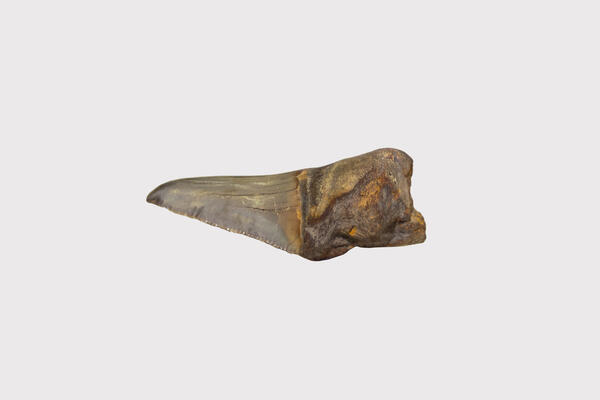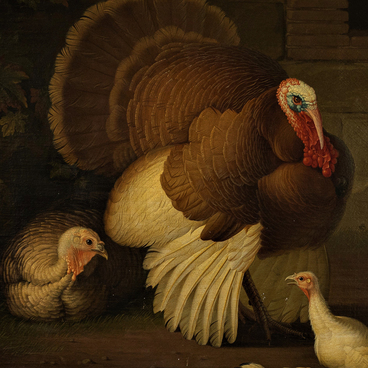The Volsk district, as well as almost the entire territory of Saratov Oblast, was once located at the bottom of the sea. The oldest deposits found in the area belong to the Jurassic and Early Cretaceous periods. Their age is 145–200 million years.
Sharks of the genus Otodus lived in this area. The tooth of one of them is presented in the collection of the Volsk Museum.
Scientists can form ideas about Otodus sharks only from fossils, teeth, and fossilized vertebrae. Teeth are the most common fossils.
It is known that the skeleton of these ancient predators, as well as of modern sharks, was formed by cartilaginous structures, so few fragments of them have survived to this day.
The places and the number of Otodus remains found by paleontologists indicate that it was a very widespread and numerous genus.
Currently, eighteen species of sharks of the genus Otodus have been described. Its most famous representatives are Otodus megalodon, or megalodons. Like all sharks of this genus, they belonged to the extinct family Otodontidae of the order Lamniformes. Megalodons lived in the Neogene period of the Cenozoic Era from 23 to 3 million years ago.
Scientists call megalodon the largest of all known fish that have ever lived on Earth. It was a large oceanic shark with a torpedo-shaped body. The length of its body could reach 10-15 meters, and the weight could go up to 47 tons. Historians suggest that although the size of other representatives of the genus Otodus was smaller, the difference was not significant.
In the megalodon jaw, up to 270 teeth were placed in several rows. The bite force of such a shark reached 109 kilonewtons — three times more than that of a modern saltwater crocodile. That was enough to open the chest of a small whale. The megalodon teeth were strong and thick, with serrations and a relatively small cutting edge. The massive root allowed the shark not to break its teeth, even when it bit into bones.
After analyzing the teeth marks of these sharks left on the bone remains of marine animals, scientists were able to establish that Otodus sharks fed on cetaceans, pinnipeds, sea turtles, and large fish. They not only hunted their prey alive, but they also picked up carrion.
Some researchers categorize sharks of the genus Otodus as apex predators, the top of a food chain, predatory animals whose numbers are not regulated by other animals. Such animals can take prey from others, destroy competitors, and provide food to other organisms that are in symbiosis with them.
Sharks of the genus Otodus, in particular megalodons, became extinct about three million years ago, when the climate of the planet began to change dramatically: the oceans cooled, and the overpopulated predators stopped having enough food. In addition, they were hunted by flocks of young toothed whales, the ancestors of modern killer whales.
Sharks of the genus Otodus lived in this area. The tooth of one of them is presented in the collection of the Volsk Museum.
Scientists can form ideas about Otodus sharks only from fossils, teeth, and fossilized vertebrae. Teeth are the most common fossils.
It is known that the skeleton of these ancient predators, as well as of modern sharks, was formed by cartilaginous structures, so few fragments of them have survived to this day.
The places and the number of Otodus remains found by paleontologists indicate that it was a very widespread and numerous genus.
Currently, eighteen species of sharks of the genus Otodus have been described. Its most famous representatives are Otodus megalodon, or megalodons. Like all sharks of this genus, they belonged to the extinct family Otodontidae of the order Lamniformes. Megalodons lived in the Neogene period of the Cenozoic Era from 23 to 3 million years ago.
Scientists call megalodon the largest of all known fish that have ever lived on Earth. It was a large oceanic shark with a torpedo-shaped body. The length of its body could reach 10-15 meters, and the weight could go up to 47 tons. Historians suggest that although the size of other representatives of the genus Otodus was smaller, the difference was not significant.
In the megalodon jaw, up to 270 teeth were placed in several rows. The bite force of such a shark reached 109 kilonewtons — three times more than that of a modern saltwater crocodile. That was enough to open the chest of a small whale. The megalodon teeth were strong and thick, with serrations and a relatively small cutting edge. The massive root allowed the shark not to break its teeth, even when it bit into bones.
After analyzing the teeth marks of these sharks left on the bone remains of marine animals, scientists were able to establish that Otodus sharks fed on cetaceans, pinnipeds, sea turtles, and large fish. They not only hunted their prey alive, but they also picked up carrion.
Some researchers categorize sharks of the genus Otodus as apex predators, the top of a food chain, predatory animals whose numbers are not regulated by other animals. Such animals can take prey from others, destroy competitors, and provide food to other organisms that are in symbiosis with them.
Sharks of the genus Otodus, in particular megalodons, became extinct about three million years ago, when the climate of the planet began to change dramatically: the oceans cooled, and the overpopulated predators stopped having enough food. In addition, they were hunted by flocks of young toothed whales, the ancestors of modern killer whales.



